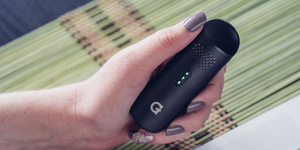“Growing cannabis in tight spaces is not my usual recommendation,” says Stephen Lipton, the cultivation manager at The Farm Recreational Marijuana Dispensary, an award-winning recreational facility in Boulder, Colorado, specializing in what it calls “craft cannabis.” At any given time, Lipton oversees close to 15,000 plants across seven different facilities in Boulder County. “If you have a really tight space and it gets too hot or too humid, you’re going to have big trouble.”
Despite the hurdles, many first-time growers still choose to cultivate cannabis indoors (which is legal in several states), and there are steps to maximize a plant’s chances of succeeding. It all starts with a plant’s genetics.
“For your typical closet setup, you’re going to want a plant that stays short,” Lipton said. “A lot of time that means an indica. Sativas are really tall and lanky.” (More on the difference between those two cannabis families here.)
While most, if not all, medical and recreational farms cultivate cannabis from seeds, guaranteeing that their plants are free from viruses, most home growers, even those with experience, typically begin with clones — essentially trimmed pieces of female cannabis plants that have been rooted in separate pots.
“When most people think of cannabis — you know, what you smoke — they’re thinking about the flowers of female plants,” Lipton said. “When you grow from seeds, half of them will be males. If you’re only going to do one or two plants, you don’t want to waste your time with that stuff.” A clone sourced from a dispensary or a knowledgeable friend guarantees that the plant is female and will eventually produce bud pending proper care. “You can get up to four ounces off the right plant — if you know what you’re doing.”
Even with a healthy clone, however, cultivating cannabis can be a long and arduous process — especially in tight indoor spaces. “A lot of people think growing is easy, but it’s not,” Lipton said. “You have to be really on it. Not everyone has success, obviously.”
For some people, cannabis cultivation is a hobby. For others, a lifelong passion. But it’s unique in its vast demographic appeal. “Everyone I know grows,” Lipton said. “There are people in their 20s doing it. I know people in their 60s. It’s a fun thing for people. You don’t have to be afraid anymore.”
Here are Lipton’s tips on growing your first plant.
-
 Gorilla Grow Tent Lite Line Read More
Gorilla Grow Tent Lite Line Read More -
 Vivosun Digital Hygrometer Indoor Outdoor Thermometer Read More
Vivosun Digital Hygrometer Indoor Outdoor Thermometer Read More -
 Levoit LV600HH Hybrid Ultrasonic Humidifier Read More
Levoit LV600HH Hybrid Ultrasonic Humidifier Read More -
 Vivosun Digital PH Meter Read More
Vivosun Digital PH Meter Read More -
 iPower GLBLST400D Horticulture 400 Watt Digital Electronic Ballast Read More
iPower GLBLST400D Horticulture 400 Watt Digital Electronic Ballast Read More
Step 1: Know your local laws
It’s important to remember that cultivating even one cannabis plant for personal consumption is a felony on the federal level and punishable by up to five years in prison. On the flip side, many U.S. states have passed local amendments, allowing citizens who are 21 years old and over to grow a limited number of plants indoors for recreational or medical use without fear of prosecution.
Even in our most progressive states, however, the law is far from simple. “In Colorado, it’s now county-specific,” Lipton said. “When the amendment first passed, they said you could grow six plants per person. But now, certain counties and municipalities have come out and said it’s just six per house — there’s no combining plant counts. That means you can have three vegetating and three flowering at any given time.”
Another layer to consider is that in many places, cannabis cultivation must happen “out of plain sight.” “You can’t have any odor," Lipton said. "If it’s offending people in the neighborhood, then it’s an issue.”
Step 2: Create the right growing environment
Before someone even begins to consider the genetics of their preferred strain, they should first ensure that their apartment is cannabis-friendly. There are five main factors to consider: space, temperature, humidity, the pH of the water and the amount of light.
Space
The space you'll need: 3' x 3' x 5', minimum.
“The bigger the space, the better. With all the lights, closets get hot,” Lipton said. That said, closets help growers control light pollution when the plant is in its flowering cycle — one of the main reasons home growers favor them over larger spaces, such as living rooms. “If you have a spare bedroom, or a basement even, you can just use that and close the door,” Lipton said.
Temperature
The proper temperature you need to remember: 68–78º Fahrenheit.
“A tool you should always have is a little temperature gauge,” Lipton said. “They call them hygrometers. They’re cheap and tell you both the temperature and the humidity.”
Relative humidity
The proper humidity you need to remember: 30–45 percent.
“If you live somewhere humid, you’re probably going to want to buy a dehumidifier,” said Lipton. “In Boulder, we sometimes have to add humidity.” At home, that can be done with a reliable humidifier.
Water pH
The proper pH you need to remember: 6.3 to 6.7.
“You’ll need a meter that you can stick into your water and tell you the pH,” Lipton said. “You want something between 6.3 to 6.7 pH for watering your plants. That sounds like pretty sophisticated stuff but it’s really not. A lot of times your tap water will be 7.8. You can use what they call pH down. That’s a crucial step.”
Lighting
The proper color temperature you need to remember: 2,200k.
“For a closet set up, I would recommend a 175-watt HPS light,” Lipton said. “Some people try to use fluorescent lighting, but I wouldn’t recommend that. You’re just not going to get a very good outcome. Nowadays, HPS lights can just go right into your home outlet, and you’d just need a timer [to set the intervals]. Position the light directly overhead. They can be pretty powerful, so you’re going to want it at least two feet from the top of the canopy [to prevent the plant from overheating].”
To learn more about our testing methodology and how we evaluate products, head here.
Step 3: Find a healthy cannabis clone
Both medical and recreational dispensaries now sell female cannabis clones, which retail for about $15. Alternatively, it’s commonplace for home growers to gift clones to their friends. “When you get a clone, someone will likely give it to you in a four-inch pot. You’re skipping that whole step of having to germinate seeds. You’re already 10, 14 days ahead of the game and basically ready to plant.”
Step 4: Plant your clone, then maintain the vegetative cycle until it's mature
Cannabis plants yield the highest-quality (and quantity) flowers after maturing. This usually takes about a month to happen. “I recommend planting in a five-gallon Home Depot bucket,” Lipton said. “It’s really important to have proper drainage, so you want to drill some holes in the bottom. The biggest mistake people make is that they overwater and suffocate the roots. Cannabis likes to be watered and dried out before it’s watered again.”
During the vegetative cycle, the plant should be exposed to a minimum of 18 hours of light. Remember to open the closet door while the lights are on to prevent the space from heading north of 78 degrees Fahrenheit.
Step 5: Trigger the flowering cycle
To understand the flowering cycle, it’s important to remember that cannabis is a plant. And, like most plants, it follows the seasons. To trigger flowering — which will take 55 to 60 days to complete — growers reduce the time plants spend exposed to the light source from 18 hours to 12. “You’re basically telling your plant it’s mid-September,” Lipton said.
Sticking to that schedule is key, he added. “Say you’re at day 30 of the flowering cycle and you come into that closet when it’s supposed to be dark and turn a bunch of lights on. You’re going to throw the whole cycle off and that’s the end of that. It only takes 10 seconds.”
Though the 12-hour interval is fairly universal, knowing exactly when to induce flowering is less clear. For the home grower, it usually comes down to space; the longer one waits to trigger the flowering cycle, the taller their plant will be. A good rule of thumb: cannabis will only continue to grow 30 to 50 percent once the light source is reduced. If the plant is growing in a closet, growers should trigger the flowering cycle, understanding that there must be more than two feet of space between the canopy of the plant throughout the entirety of its life.
Step 6: Harvest and cure your buds
After 55 to 60 days, growers begin paying close attention to their plants’ trichomes — the small, bulbous fibers that develop around the flower of the female plant. “Those trichomes will turn from clear to amber,” Lipton said. “They kind of look like red hairs. You know it’s time to harvest when about 10 to 15 percent of the trichomes turn that color.” On average, cannabis plants have a five- to seven-day window of peak harvest time.
To harvest, many growers begin by removing the leaves of the cannabis plant with trim scissors, followed by the buds (using pruners). “We call this bucking,” Lipton said. “Gloves are also extremely important for sanitation reasons as well as to keep your hands from becoming sticky with the resin from the plant.”
The last step involves curing the bud. “Curing is just as important as the growing process,” Lipton added. “We do a slow cure, which means that it takes anywhere from three to six weeks depending on variety.” Temperature and humidity play a large role during cure and must be maintained to ensure a great final product. “Our actual cure process is somewhat of a secret, so I cannot share the fine details,” Lipton said. “But it’s an art form and extremely crucial to our success.” The reason growers cure bud after harvesting is that it creates a smoother smoke and increases its potency.
































